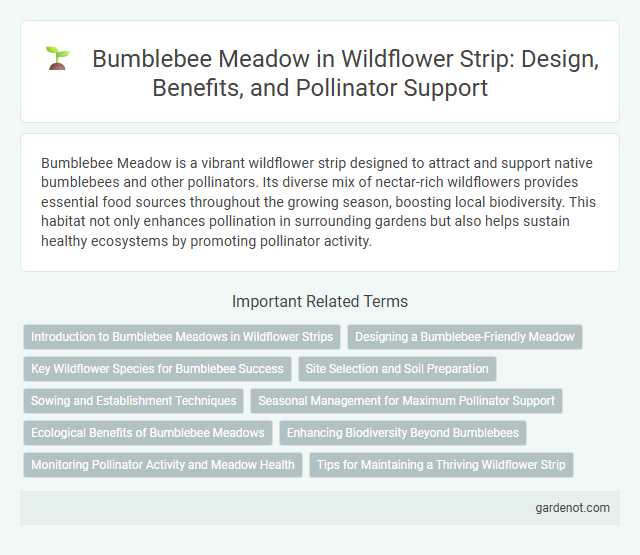Bumblebee Meadow is a vibrant wildflower strip designed to attract and support native bumblebees and other pollinators. Its diverse mix of nectar-rich wildflowers provides essential food sources throughout the growing season, boosting local biodiversity. This habitat not only enhances pollination in surrounding gardens but also helps sustain healthy ecosystems by promoting pollinator activity.
Introduction to Bumblebee Meadows in Wildflower Strips
Bumblebee meadows within wildflower strips serve as vital habitats by providing diverse floral resources that support pollinator populations. These meadows enhance biodiversity, promoting natural pest control and improved crop pollination services. Integrating bumblebee meadows into agricultural landscapes optimizes ecosystem health and sustainability.
Designing a Bumblebee-Friendly Meadow
Designing a bumblebee-friendly meadow involves selecting native wildflowers that provide continuous blooms from spring through late summer, ensuring a reliable pollen and nectar source for bumblebees. Incorporating a diverse mix of flower shapes and colors attracts various bumblebee species, supporting their foraging needs and promoting ecosystem biodiversity. Proper soil preparation and avoiding pesticides enhance habitat quality, enabling a thriving bumblebee population in the meadow.
Key Wildflower Species for Bumblebee Success
Bumblebee meadows thrive with key wildflower species such as red clover (Trifolium pratense), devil's-bit scabious (Succisa pratensis), and bird's-foot trefoil (Lotus corniculatus), which provide essential nectar and pollen throughout the growing season. Native wildflowers like oxeye daisy (Leucanthemum vulgare) and common knapweed (Centaurea nigra) also enhance habitat diversity and support bumblebee foraging. The presence of these species significantly boosts bumblebee population health and pollination efficiency in wildflower strips.
Site Selection and Soil Preparation
Selecting a sunny, well-drained site with minimal shade is essential for establishing a thriving Bumblebee meadow. Soil preparation involves loosening the soil to a depth of 6-8 inches and removing weeds to reduce competition for nutrients. Incorporating organic matter improves soil structure and fertility, promoting robust growth of wildflowers that attract and support bumblebee populations.
Sowing and Establishment Techniques
Sowing a bumblebee meadow requires selecting native wildflower seeds with a mix of early, mid, and late-blooming species to ensure continuous forage. Preparation involves clearing existing vegetation and creating a fine, firm seedbed to optimize seed-to-soil contact for better germination. Proper timing, typically in early spring or fall, combined with light rolling or tamping after sowing, promotes successful establishment and supports bumblebee populations.
Seasonal Management for Maximum Pollinator Support
Seasonal management of bumblebee meadows involves timed planting and mowing to ensure continuous availability of diverse nectar and pollen sources throughout the growing season. Early spring blooms support emerging queen bumblebees, while late-season flowers provide essential resources for colony buildup and overwintering preparation. Strategic removal of invasive species and reducing pesticide use are critical for maintaining habitat quality and promoting robust pollinator populations.
Ecological Benefits of Bumblebee Meadows
Bumblebee meadows enhance biodiversity by providing essential foraging habitats rich in native wildflowers, supporting multiple bumblebee species and other pollinators. These meadows improve pollination services, which increase crop yields and sustain local ecosystems. Their dense floral diversity also promotes soil health and natural pest control, contributing to overall ecosystem resilience.
Enhancing Biodiversity Beyond Bumblebees
Bumblebee meadows planted with diverse wildflower strips significantly enhance biodiversity by attracting a wide range of pollinators, including solitary bees, butterflies, and hoverflies. These habitats support native flora by improving pollination rates, which in turn sustain local ecosystems and increase wildlife resilience. Wildflower strips also create corridors that connect fragmented habitats, promoting genetic diversity and ecosystem health beyond the presence of bumblebees alone.
Monitoring Pollinator Activity and Meadow Health
Monitoring pollinator activity in the Bumblebee meadow involves regular surveys of bumblebee species diversity, abundance, and foraging behavior using standardized transect walks and digital tracking methods. Data collected on pollen collection rates and flower visitation patterns are critical for assessing meadow health and the effectiveness of wildflower strips in supporting pollinator populations. This ongoing ecological monitoring helps identify potential threats such as habitat loss or pesticide exposure, enabling timely conservation interventions to maintain a thriving pollinator habitat.
Tips for Maintaining a Thriving Wildflower Strip
Regularly monitor soil moisture levels to ensure optimal hydration for bumblebee meadow wildflowers, promoting vibrant blooms and abundant nectar. Implement targeted weed control techniques such as hand-pulling or selective herbicides to reduce competition and preserve native plant diversity. Incorporate seasonal pruning and deadheading practices to encourage continuous flowering and sustain a healthy habitat for pollinators throughout the growing season.
Bumblebee meadow Infographic

 gardenot.com
gardenot.com